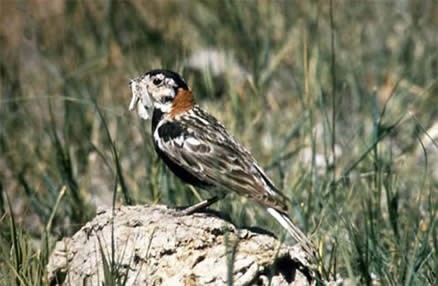Chestnut-collared Longspur
A species of Longspurs Scientific name : Calcarius ornatus Genus : Longspurs
Chestnut-collared Longspur, A species of Longspurs
Botanical name: Calcarius ornatus
Genus: Longspurs
Content
Description General Info
Description
These birds have a short conical bill, a streaked back and a white tail with a dark tip. In breeding plumage, the male has black underparts, a chestnut nape, a yellow throat and a black crown. Other birds have light brown underparts, a dark crown, brown wings and may have some chestnut on the nape. Measurements: Length: 5.1-6.5 in (13-16.5 cm) Weight: 0.6-0.8 oz (17-23 g) Wingspan: 25-27 cm 
Size
15-17 cm (5.75-6.5 in)
Life Expectancy
4 years
Nest Placement
Ground
Clutch Size
3 - 5 eggs
Incubation Period
2 - 3 broods
Number of Broods
7 - 15 days
Nestling Period
7 - 15 days
Feeding Habits
Chestnut-collared Longspur's diet primarily consists of insects, notably grasshoppers, and seeds. They forage by picking food from the ground or low vegetation and also engage in flycatching insects near the ground.
Habitat
Chestnut-collared Longspur predominantly inhabits shortgrass and mixed-grass prairies of the northern Great Plains, favoring areas with grass shorter than 1 foot. This species thrives in environments shaped by grazing, mowing, or burning, which maintain the short-grass conditions it prefers. During migration, chestnut-collared Longspur frequents prairie dog towns, fallow fields, and croplands. Winter habitats include the southern Great Plains and the Chihuahuan Desert's shortgrass prairie and desert grasslands, avoiding areas with significant shrub cover and overly grazed regions.
Nest Behavior
Female chestnut-collared Longspurs construct the nest and lay eggs, with nesting activities timed with the availability of grassland cover. Parents are involved in caring for the young, with specific roles in feeding and protection.
Nest Characteristics
The chestnut-collared Longspur nest is a ground depression often placed by a cow pie, situated in taller vegetation patches within shortgrass prairies. It is lined with grass, occasionally incorporating hair or feathers, measuring roughly 3.5 inches in width and 2 inches in depth.
Dite type
Insectivorous
General Info
Feeding Habits
Bird food type
Behavior
Chestnut-collared Longspur engage in frequent foraging among grasslands, delicately traversing through grass in search of sustenance. Notable for their aerial song display, males ascend dramatically to entice mates, their lyrical descent as eye-catching as their spread tail. Perched atop modest elevations, they vocalize terrestrially as well. With a tendency for social monogamy, chestnut-collared Longspur are observed to breed twice per season, occasionally involving extra-pair copulations. They exhibit territorial instincts during mating periods, yet display a strikingly gregarious nature in colder seasons, forming substantial flocks that mirror a collective spirit of unity.
Distribution Area
This bird breeds in short and mixed grass prairies in central Canada and the north central United States. In winter, they migrate in flocks to prairies and open fields in the southern United States and Mexico. Like other prairie birds, they have disappeared from some areas because of habitat loss but are still fairly common. Controlled burns may benefit this species as they feed on low-growing plants that are more easily spotted after a fire. 
Species Status
VULNERABLE. Classified as “Declining” in the USA (Yellow WatchList priority species for conservation).
Scientific Classification
Phylum
Chordates Class
Birds Order
Perching birds Family
Longspurs and snow buntings Genus
Longspurs Species
Chestnut-collared Longspur 